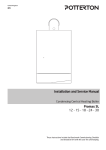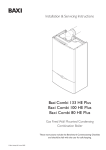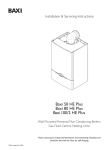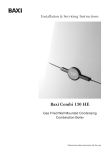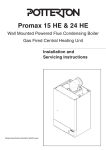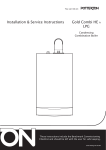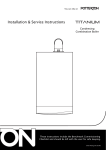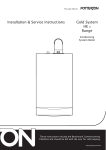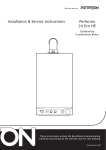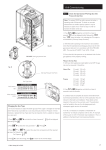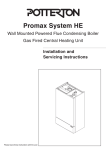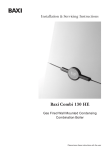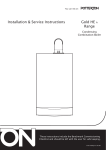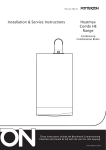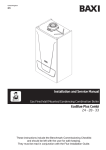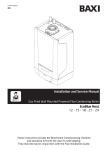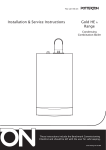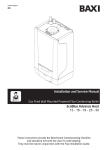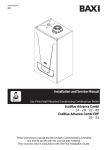Download Baxi Potterton Gold FSB 30 HE Boiler User Manual
Transcript
You can rely on Installation & Service Instructions Gold FSB 30 HE Floor Standing Condensing Boiler These instructions include the Benchmark Commissioning Checklist and should be left with the user for safe keeping. © Baxi Heating UK Ltd 2011 Natural Gas Potterton Gold FSB 30 HE G.C. No. 41 592 32 Building Regulations and the Benchmark Commissioning Checklist Building Regulations (England & Wales) require notification of the installation of a heating appliance to the relevant Local Authority Building Control Department. From 1 April 2005 this can be achieved via a Competent Persons Self Certification Scheme as an option to notifying the Local Authority directly. Similar arrangements will follow for Scotland and will apply in Northern Ireland from 1 January 2006. The Health & Safety Executive operates the ‘Gas Safe Register’, a self-certification scheme for gas heating appliances. These arrangements represent a change from the situation whereby compliance with Building Regulations was accepted as being demonstrated by completion of the Benchmark Logbook (which was then left on site with the customer). With the introduction of Self Certification Schemes, the Benchmark Logbook is being withdrawn. However, a similar document in the form of a commissioning checklist and service interval record is incorporated at the back of these instructions. The Benchmark Scheme Benchmark places responsibilities on both manufacturers and installers. The purpose is to ensure that customers are provided with the correct equipment for their needs, that it is installed, commissioned and serviced in accordance with the manufacturer’s instructions by competent persons and that it meets the requirements of the appropriate Building Regulations. The Benchmark Checklist can be used to demonstrate compliance with Building Regulations and should be provided to the customer for future reference. Installers are required to carry out installation, commissioning and servicing work in accordance with the Benchmark Code of Practice which is available from the Heating and Hotwater Industry Council who manage and promote the Scheme. Visit www.centralheating.co.uk for more information. © Baxi Heating UK Ltd 2011 All rights reserved. No part of this publication may be reproduced or transmitted in any form or by any means, or stored in any retrieval system of any nature (including in any database), in each case whether electronic, mechanical, recording or otherwise, without the prior written permission of the copyright owner, except for permitted fair dealing under Copyrights, Designs and Patents Act 1988. This company is a member of the Benchmark initiative and fully supports the aims of the programme. Its aim is to improve the standards of installation and commissioning of central heating systems in the UK and to encourage the regular servicing of all central heating systems to ensure safety and efficiency. Building Regulations require that installations should comply with manufacturer's instructions. It is therefore important that the commissioning checklist is completed by the installer. The relevant section of Building Regulations only relates to dwellings. Therefore the checklist only applies if the appliance is being installed in a dwelling or some related structure. The flowchart opposite gives guidance for installers on the process necessary to ensure compliance with Building Regulations. Applications for the copyright owner’s permission to reproduce or make other use of any part of this publication should be made, giving details of the proposed use, to the following address: The Company Secretary, Baxi Heating UK Limited, Brooks House, Coventry Road, Warwick. CV34 4LL Full acknowledgement of author and source must be given. WARNING: Any person who does any unauthorised act in relation to a copyright work may be liable to criminal prosecution and civil claims for damages. 0086 ISO 9001 FM 00866 2 © Baxi Heating UK Ltd 2011 Installer Notification Guidelines Choose Building Regulations Notification Route Competent Person's Self Certification Scheme Building Control Install and Commission this appliance to manufacturer's instructions Contact your relevant Local Authority Building Control (LABC) who will arrange an inspection or contact a government approved inspector Complete the Benchmark Checklist If you notify via the ‘Gas Safe Register’, the register will issue the Building Regulations certificate on members’ behalf Install and Commission this appliance to manufacturer's instructions Scheme Members only Call ‘Gas Safe Register’ on: 0800 408 5577 or log onto: www.gassaferegister.co.uk within 10 days Complete the Benchmark Checklist You must ensure that the certificate number issued by the ‘Gas Safe Register’ is written onto the Benchmark Checklist ‘Gas Safe Register’ will issue a Building Regulations Compliance Certificate to the property owner and inform the relevant LABC © Baxi Heating UK Ltd 2011 LABC will record the data and will issue a certificate of compliance 3 Legislation IMPORTANT - Installation, Commissioning, Service & Repair This appliance must be installed in accordance with the manufacturer’s instructions and the regulations in force. Read the instructions fully before installing or using the appliance. In GB, this must be carried out by a competent person as stated in the Gas Safety (Installation & Use) Regulations. Definition of competence: A person who works for a Gas Safe registered company and holding current certificates in the relevant ACS modules, is deemed competent. In IE, this must be carried out by a competent person as stated in I.S. 813 “Domestic Gas Installations”. The addition of anything that may interfere with the normal operation of the appliance without express written permission from the manufacturer or his agent could invalidate the appliance warranty. In GB this could also infringe the Gas Safety (Installation and Use) Regulations. Warning - Check the information on the data plate is compatible with local supply conditions. All Gas Safe registered engineers carry an ID card with their licence number and a photograph. You can check your engineer is registered by telephoning 0800 408 5500 or online at www.gassaferegister.co.uk The boiler meets the requirements of Statutory Instrument “ The Boiler (Efficiency) Regulations 1993 No 3083” and is deemed to meet the requirements of Directive 92/42/EEC on the energy efficiency requirements for new hot water boilers fired with liquid or gaseous fuels:Type test for purpose of Regulation 5 certified by: Notified Body 0087. Product/Production certified by: Notified Body 0086. For GB/IE only. This company declare that no substances harmful to health are contained in the appliance or used during appliance manufacture. The appliance is suitable only for installation in GB and IE and should be installed in accordance with the rules in force, and only used in a suitably ventilated location. In GB, the installation must be carried out by a Gas Safe Registered Installer. It must be carried out in accordance with the relevant requirements of the: • Gas Safety (Installation & Use) Regulations. • The appropriate Building Regulations either The Building Regulations, The Building Regulations (Scotland), Building Regulations (Northern Ireland). • The Water Fittings Regulations or Water Byelaws in Scotland. • The Current I.E.E. Wiring Regulations. Where no specific instructions are given, reference should be made to the relevant British Standard Code of Practice. In IE, the installation must be carried out by a competent Person and installed in accordance with the current edition of I.S. 813 ‘Domestic Gas Installations’, the current Building Regulations and reference should be made to the current ETCI rules for electrical installation. All systems must be thoroughly flushed and treated with inhibitor (see section 6.2). Codes of Practice, most recent version should be used In GB the following Codes of Practice apply: Standard Scope BS 6891 Gas Installation. BS 5482 Part 1 Butane & Propane Gas Installation BS 5546 Installation of hot water supplies for domestic purposes. BS EN 12828 Heating systems in buildings. BS EN 12831 Heating systems in buildings - Calculation of load. BS EN 14336 Installation & commissioning of water based heating systems. BS 6798 Installation of gas fired hot water boilers. BS 5440 Part 1 Flues. BS 5440 Part 2 Ventilation. BS 7074 Expansion vessels and ancillary equipment for sealed water systems. BS 7593 Treatment of water in domestic hot water central heating systems. In IE the following Codes of Practice apply: Standard Scope I.S. 813 Domestic Gas Installations. The following standards give valuable additional information; BS 5546 Installation of hot water supplies for domestic purposes. BS EN 12828 Heating systems in buildings. BS EN 12831 Heating systems in buildings - Calculation of load. BS EN 14336 Installation & commissioning of water based heating systems. BS 7074 Expansion vessels and ancillary equipment for sealed water systems. BS 7593 Treatment of water in domestic hot water central heating systems. 4 © Baxi Heating UK Ltd 2011 Contents Section © Baxi Heating UK Ltd 2011 Page 1.0 Introduction 6 2.0 General Layout 7 3.0 Boiler Operation 8 4.0 Technical Data 9 5.0 Dimensions and Fixings 10 6.0 System Details 11 7.0 Site Requirements 15 8.0 Flue Options 20 9.0 Plume Displacement 25 10.0 Installation 29 11.0 Electrical 34 12.0 Commissioning the Boiler 36 13.0 Completion 38 14.0 Servicing the Boiler 39 15.0 Changing Components 42 16.0 Short Parts List 49 17.0 Fault Finding 50 Benchmark Checklist 58 5 Facia Securing Screws 1.0 Introduction 1.1 Description Optional Integral Timer 1. The Potterton Gold FSB 30 HE is a gas fired room sealed fan assisted condensing central heating boiler. 2. The maximum output of the boiler is 30.18 kW (Non Condensing) 32.61 kW (Condensing). Position of Label 3. The boiler is designed for use on Natural Gas (G20) only. 4. The boiler is suitable for fully pumped open vented and sealed systems, providing heating and hot water. 5. A label giving details of the model, serial number and Gas Council number is situated on the rear of the drop down facia panel (Fig. 1). 6. The boiler data badge is positioned on the air box door (Fig. 2). Fig. 1 7. The boiler is intended to be installed in residential / commercial / light industrial E.M.C. environments on a governed meter supply only. 8. The boiler must be installed with one of the purpose designed flues such as the standard horizontal flue kit, part no 236921. Case Securing Screws 1.2 Important Information Man-made mineral fibre • Some component parts of this boiler (insulation pads, gaskets and rope seals) are manufactured from man-made mineral fibre. • Prolonged or excessive exposure to this material may result in some irritation to the eyes, skin or respiratory tract. • It is advisable to wear gloves when handling these items. • Irritant dust will only be released from the items if they are broken up or subjected to severe abrasion. In these instances a suitable dust mask and goggles should be worn. • Always thoroughly wash hands after installation, servicing or changing components. • When disposing of any items manufactured from manmade mineral fibre care must be exercised. • If any irritation of the eyes or severe irritation of the skin is experienced seek medical attention. Air Box Door Fig. 2 Data Badge 6 © Baxi Heating UK Ltd 2011 2.0 General Layout 2.1 16 Fig. 5 2 15 14 17 18 13 3 12 9 19 4 6 1. Condensate Pump 2. Flue Elbow (supplied in std. flue kit) 3. Heat Exchanger 4. Burner 5. Air Box 6. Fan Protection Thermostat - Black 7. Fan Assembly 8. Condensate Trap 9. PCB Housing Assembly 10. Gas Tap 11. Gas / Air Ratio Valve 12. Flow Pipe Connection 13. Return Pipe Connection 14. Flow Temperature Safety Thermostat - Black 15. Flow Temperature Thermistor - Red 16. Flow Switch (dry fire protection) 17. Position of Optional Integral Timer Wiring 18. Pipe Access Panel 19. Manual Air Vent 2.2 5 Layout (Figs. 3, 4, 5 & 6) 110Ø Concentric Flues & Optional Extras KIT PART No Standard Flue Kit 850mm (inc. elbow) 236921 Extended Flue Kit - 1.75M ( inc. elbow) 5111457 Flue Plume Deflector Kit 248167 Terminal Guard (suitable for use with above) 248484 FLUE EXTENSION KITS (110/70) Flue Extension 250mm 241692 Flue Extension 500mm 241694 Flue Extension 1000mm (Use two kits for 2M etc.) 241695 Flue Bend x 2 - 45° (Reduce overall length of flue by 0.5m when fitting this bend) Fig. 3 241689 Flue Bend - 93° (Reduce overall length of flue by 1m when fitting each bend) 7 241687 VERTICAL FLUE 1 Vertical Flue Terminal 242802 Vertical Flue Adaptor 5106888 See Section 7.12 for more flue option details 8 Integral Twin Channel Timer 5117696 11 Fig. 4 © Baxi Heating UK Ltd 2011 Fig. 6 10 7 3.0 Boiler Operation 3.1 Mains On. Condensate Pump will operate as necessary (3.1.9) Flow temperature less than set point ? 3. Fan Pre-Purge: The flow switch is made and the fan is on while the spark generator and gas valve are off. After 5 seconds ignition occurs. System Pump Running and Flow switch made ? YES 5 second Fan Pre-Purge. YES Ignition done and less than 5 attempts made ? Flame Detected ? Ignition done and 5 attempts made ? All TRVs shut or Flow temperature greater than set point ? 5 second Fan Post Purge. YES All TRVs shut down ? 3 minute Anti-cycle. 8 © Baxi Heating UK Ltd 2011 6. Fan Post Purge: The fan is on while the spark generator and gas valve are off. After 5 seconds if the TRVs are shut down then anti-cycle occurs. 7. Anti-cycle: The fan, spark generator and gas valve are off. YES Burner On. 4. Ignition: The flow switch is made, fan, spark generator and gas valve are on. If a flame is detected then burner on occurs. If a flame is not detected within 5 seconds and less than 5 ignition attempts have been made then fan purge occurs. If a flame is not detected within 5 seconds and 5 ignition attempts have been made then ignition lockout occurs. 5. Burner On: The flow switch is made, fan and gas valve are on while the spark generator is off. Flow temperature is controlled by varying the fan speed (and thereby the gas rate) to achieve optimum operation. If the flow temperature is greater than the set point or the TRVs all shut down then fan post purge occurs. 5 second Ignition Period. YES 1. Switched Live On: When switched live is supplied to the boiler and the flow temperature is less than the set point the sequence below commences. 2. Flow Switch: After 10 seconds if the flow switch has made then fan pre-purge occurs. After 10 seconds if the flow switch has not made then anti-cycle occurs. YES NO Boiler Operation YES Ignition Lockout. 8. Ignition Lockout: The fan, spark generator and gas valve are off. The boiler can only be reset by manually using the reset button. 9. Condensate Pump: Condensate accumulates in a reservoir within the pump assembly. The pump may run at any time, independent of boiler operation, to discharge the condensate to drain. 4.0 Technical Data C13 Appliance Category Heat Input (Q)(Gross) kW C33 CAT I 2H Max Min 33.76 10.3 Heat Output (P) (Non Condensing 70° C Mean Water Temp) Max Min kW 30.18 9.2 Heat Output (P) (Condensing 40° C Mean Water Temp) Max Min kW 32.61 10.0 Max Gas Rate (2H - G20 - 20mbar) (After 10 Mins) kW Input 33.76 m3/hr 3.4 Inlet Pressure at Gas Valve (Natural Gas) Min 18.1 mbar Max 22.5 mbar (see Section 10.1) Injector (Natural Gas) Diameter 6.5mm CO/CO Ratio 0.004 NOx Class 5 2 Horizontal Flue Terminal Dimensions Diameter Projection - Connections Gas Supply Central Heating Flow Central Heating Return Condensate Drain (Pump) Outercase Dimensions Casing Height Casing Width Casing Depth - - 110mm 150mm Electrical Supply 230V~ 50Hz The boiler must be connected to an earthed supply. A permanent and switched live are required. The boiler has a 4 wire connection. 15mm 28mm 28mm 10mm o.d. 850mm 390mm 520mm (For unventilated compartments see Section 7.2) Weights Packaged Boiler Carton Packaged Flue Kit Installation Lift Weight Installed Weight (dry) Recommended System Temperature Drop Condensing - 5mm 15mm - 25mm 500mm 5mm - kg 49.5 3.6 37.5 44.5 80W External Fuse Rating 3A Internal Fuse Rating (BS 4265) Fuse 3.15 AT (PCB) Minimum Clearances Both Sides Above Casing Above Casing Under fixed worktop (It is recommended that any worktop is removable) Front (For Servicing) Front (In Operation) Power Consumption Electrical Protection IPXX Water Content litres 2.6 Static Head max min Low Head 0.2m min System Detail Fully pumped open vented & sealed systems. No bypass required. Controls boiler thermostat, safety thermostat, flow switch, electronic flame sensing, temperature protection thermostat & condensate blockage and level sensors Boiler Flow Temperature (adjustable) 55° C to 78° C (± 5° C) 20°C Condensate Pump Head Flow Rate Connection Assessment Procedure (SAP) for energy rating of dwellings. The test data from which it has been calculated has been certified by 0087. Pressure Drop (mbar) This value is used in the UK Government’s Standard 3 metres 1.8 l/min 10mm o.d. (pipe supplied) Boiler Hydraulic Resistance Chart SEDBUK Declaration SAP 2005 Seasonal Efficiency model is 90.9% 30 metres 1 metre 91 83 75 66 58 50 42 33 25 17 8 220 200 180 160 140 120 100 80 60 40 20 0 10 20 30 Pressure Drop (in wg) Appliance Type 40 Water Flow Rate (litres/min) © Baxi Heating UK Ltd 2011 9 5.0 Dimensions and Fixings DIMENSIONS At least 1.5° A 850mm B 520mm C 390mm A D 125mm Ø Min. E 175mm F 150mm B C D Flue Ø 110mm Fig. 7 The 1.5° fall provided by the elbow is to allow condensate to run back to the boiler, for discharge through the condensate disposal system. F E Y X At least 1.5° Fig. 8 10 © Baxi Heating UK Ltd 2011 SIDE FLUE (left and right) For every 1m of horizontal flue length, the clearance above the top of the flue elbow should be 27.5mm to incorporate the 1.5° fall in the flue from the terminal to the elbow. It is especially important to consider this when fitting the boiler under a work top ! Flue length (Y) Clearance (X) up to 1m 27.5mm 1m - 2m 55mm 2m - 3m 82.5mm 3m - 4m 110mm 6.0 System Details 6.1 Water Circulating Systems 1. The boiler is suitable for use with open vent fully pumped systems and sealed systems . The following conditions should be observed on all systems: • The static head must not exceed 30m of water. • The boiler must not be used with a direct cylinder. • Drain cocks should be fitted to all system low points. • All gas and water pipes and electrical wiring must be installed in a way which would not restrict the servicing of the boiler. • Position isolating valves as close to circulating pump as possible. 6.2 Treatment of Water Circulating Systems 1. All recirculatory water systems will be subject to corrosion unless they are flushed and an appropriate water treatment is applied. To prevent this, follow the guidelines given in BS 7593 “Treatment of Water in Domestic Hot Water Central Heating Systems” and the treatment manufacturers instructions. 2. Treatment must involve the use of a proprietary cleanser, such as Sentinel X300 or X400, or Fernox F3 and an inhibitor such as Sentinel X100 or Fernox MB-1. 3. Full instructions are supplied with the products, for further information contact Sentinel (0800 389 4670) or Fernox (0870 870 0362). Failure to flush and add inhibitor to the system will invalidate the appliance warranty. 4. It is important to check the inhibitor concentration after installation, system modification and at every service in accordance with the inhibitor manufacturer’s instructions. (Test kits are available from inhibitor stockists.) 5. For information or advice regarding any of the above contact Technical Enquiries 0844 871 1555. © Baxi Heating UK Ltd 2011 11 Boiler Air Vent 6.0 System Details Copper 0.5m Copper 0.5m Flow Boiler 6.3 Return Copper 1m 1. The sizes of flow and return pipes from the boiler should be determined by normal methods, according to the requirements of the system. Fig. 9 m 00m 5 45° 1000mm Min Boiler Air Vent 2. The connection tails for the boiler are 28mm diameter. The 28mm section of the tails can be cut back to 22mm if required. 22mm Open Vent 3. The flow & return tails are push - fit ‘O’ ring and clip connections within the boiler case. 15mm Cold Feed 400mm Min Head 4. A 20 °C drop in temperature across the system is recommended for condensing boilers. Existing radiators may be oversized and so allow this, but where radiator sizing is marginal it may be advisable to retain a system temperature drop of 11°C. 150mm Max Boiler Pump 5. In systems using non-metallic pipework it is necessary to use copper pipe for the boiler Flow and Return. The copper must extend at least 1 metre from the boiler and include any branches (Fig. 9). Flow Return Typical Low Head Installation Fig. 10 mm 6. This boiler does not require a bypass. 6.4 22mm Open Vent 500 15mm Cold Feed 1000mm Min Boiler 400mm Min Head a) The pump being adjusted to give a 20°C drop across the boiler. b) The pump must be fitted on the flow. c) The pump must be fitted in accordance with the pump manufacturer's instructions. d) The open vent pipe must be taken up from a tee in a horizontal section of the flow pipe. 150mm Max Pump Flow Return If Conditions Require, This System Possible Fig. 11 2. For heads below 400mm then an alternative utilising a combined vent and feed pipe may be connected (Fig. 12). This must be a minimum of 22mm diameter. It is recommended that an air separator is fitted when using a combined feed and vent pipe. 6.5 200mm Min Boiler Air Vent 1. A manual air vent is fitted on the flow pipe, to enable complete venting of the boiler. The pipe access panel must be removed to do this. Air Separator Pump Flow Return Fig. 12 12 © Baxi Heating UK Ltd 2011 Air Vents For correct operation of the flow switch the boiler and system MUST be completely vented. 22mm Feed & Vent Pipe Boiler Low Head Installation 1. Using a close couple arrangement the minimum head is as shown in the diagrams (Figs. 10 & 11) subject to the following conditions: 45° Boiler Air Vent Pipework Alternative Low Head Installation 2. Additional vents should be fitted at suitable points on the system as required. Key to colours b br w o gr g/y - Blue Brown White Orange Grey Green/Yellow 6.0 System Details 6.6 This boiler requires a permanent live for operation of the condensate pump and frost protection. 230V 50Hz L N E w Cylinder Stat gr 1 Room Stat 1. To comply with Part L1 of the Building Regulations the heating system into which the boiler is installed should include the following: Y Plan Diverter Valve b g/y a) zone controls b) timing controls c) boiler control interlocks o C 2 S/L E N P/L System Control Wiring Centre Boiler Connection (4 Core Wire) Timer L N CH on HW on HW off 2. Such a system needs to be fully pumped and must provide independent temperature and time control to both the heating and hot water circuits and have a boiler and system pump interlock. 3. The boiler should be controlled so that it operates on demand only. Where it is proposed to effect control by thermostatic radiator valves a room thermostat should also be provided to switch off the boiler when there is no demand for heating. NE L Pump Y Plan, Room Thermostat System, CH Interlocked By Room Thermostat, DHW Interlocked By Cylinder Thermostat At least the Radiator(s) near the Room Thermostat not TRV’d Pump run from Switched Live 230V 50Hz System Controls & Wiring gr b gr L N E Motor b Motor br br g/y S Plan Valve Room Cylinder Stat Stat o g/y S Plan Valve o S/L E System Control Wiring Centre N P/L Boiler Connection (4 Core Wire) Timer L N CH on HW on NE L Pump S Plan, Room Thermostat System, CH Interlocked By Room Thermostat, DHW Interlocked By Cylinder Thermostat At least the Radiator(s) near the Room Thermostat not TRV’d Pump run from Switched Live © Baxi Heating UK Ltd 2011 13 6.0 System Details 3 Litre Top Up Bottle (if required) Air Vent Safety Valve Filling Point Pressure Gauge Pump Radiator Circuit Expansion Vessel System Drains at Low Point Max Boiler Flow Temp = 82° C Method of determining minimum expansion vessel volume for sealed systems. Vessel Charge Pressure (Bar) Initial System Pressure (Bar) Multiply Total Water Content Of System By (Litres) 0.5 0.5 1.0 1.5 2.0 0.067 0.112 0.207 0.441 1.0 1.5 2.0 0.087 0.152 0.330 1.5 2.0 0.125 0.265 1.0 1.5 Example :- System Volume = 75 litres Vessel Charge Pressure = 1.0 bar Initial System Pressure = 1.5 bar Then :- 75 x 0.152 = 11.4 litres Expansion Vessel Volume Table. 1 Sealed Systems (Fig. 13) 1. SAFETY VALVE - A safety valve complying with the requirements of BS 6750 Part 1 must be fitted close to the boiler on the flow pipe by means of a horizontal or vertically upward connection with no intervening valve or restrictions and should be positioned to facilitate testing. The valve should be pre-set and non-adjustable to operate at a pressure of 3 bar (45 Ibf/in2). It must be arranged to discharge any water or steam through a pipe to a safe outlet position. 2. PRESSURE GAUGE - A pressure gauge of minimum range 0-4 bar (0-60 Ibf/in2) with a fill pressure indicator must be fitted to the system, preferably at the same point as the expansion vessel in an easily visible position. Boiler Fig. 13 6.7 NOTE Where a vessel of the calculated size is not obtainable then the next available larger size should be used. 3. EXPANSION VESSEL - An expansion vessel complying with the requirements of BS 4814 must be fitted to the system by means of a connection close to the inlet side of the circulating pump in accordance with the manufacturers instructions, the connecting pipe being unrestricted and not less than 15mm (1/2 in) nominal size. The volume of the vessel should be suitable for the system water content and the nitrogen or air charge pressure should not be less than the system static head (See Table. 1). Further details of sealed system design can be obtained from BS 5449 and the British Gas publication entitled 'Specifications for Domestic Wet Central Heating Systems'. 4. FILLING POINT - A filling point connection on the central heating return pipework must be provided to facilitate initial filling and pressurising and also any subsequent water loss replacement / refilling. The sealed primary circuits may be filled or replenished by means of a temporary connection between the primary circuit and a supply pipe provided a ‘Listed’ double check valve or some other no less effective backflow prevention device is permanently connected at the inlet to the circuit and the temporary connection is removed after use. The filling method adopted must be in accordance with all relevant water supply regulations and use approved equipment. Your attention is drawn to, for GB: Guidance G24.2 and recommendation R24.2 of the Water Regulations Guide. for IE: the current edition of I.S. 813 “Domestic Gas Installations”. 5. MAKE UP SYSTEM - A method of replacing water lost from the system should be provided either by means of a make up vessel of not more than 3 litres (5 pints) capacity, mounted above the highest point of the system, or by re-pressurisation of the system. 6. VENTING - A method of venting the system during filling and commissioning must be provided by fitting automatic air vents or by venting manually. Stop Valve Double Check Valve 7. HOT WATER STORAGE - The hot water storage vessel must be of the indirect coil type. Stop Valve 8. COMPONENTS - All components used in the system must be suitable for operation at 110°C (230°F) and at the pressure allowed by the safety valve. Mains Inlet Temporary Hose Fig. 14 14 © Baxi Heating UK Ltd 2011 CH Return 7.0 Site Requirements 7.1 Location NOTE: Due to the high efficiency of the boiler a plume of water vapour will be discharged from the flue. This should be taken into account when siting the flue terminal. 1. The boiler must be fitted on a suitable flat and level surface capable of supporting the weight. Any wall behind the boiler must be at 90° to the floor to allow case top cover to fit correctly. Zone 2 2. The flue must pass through an outside wall or roof and discharge to atmosphere in a position permitting satisfactory removal of combustion products and providing an adequate air supply. Window Recess Zone 1 Zone 2 3. The boiler should be fitted within the building unless otherwise protected by a suitable enclosure i.e. garage or outhouse. Zone 0 0.6 m 4. The boiler incorporates a frost protection device. This will only protect the boiler. To ensure protection of the system pipework and components it is recommended to incorporate an appropriate device within the system controls. Window Recess Zone 2 Fig. A In GB Only Ceiling Window Recess Zone 2 Zone 1 Zone 2 Outside Zones 2.25 m Zone 0 0.6 m Fig. B In GB Only 5. If the boiler is fitted in a room containing a bath or shower, it can only be fitted in Zone 3, (Figs. A & B shows zone dimensions for a bathtub. For other examples refer to the Current I.E.E. Wiring Regulations). Reference must be made to the relevant requirements:In GB this is the current I.E.E. Wiring Regulations and Building Regulations. In IE reference should be made to the current edition of I.S. 813 “Domestic Gas Installations” and the current ETCI rules. 6. If the boiler is to be fitted into a building of timber frame construction then reference must be made to the current edition of Institute of Gas Engineers Publication IGE/UP/7 (Gas Installations in Timber Framed Housing). 7.2 Compartment 1. Where the boiler is installed in a cupboard or compartment, no air vents are required for cooling purposes providing that the minimum dimensions below are maintained. Width 400mm Height 875mm Depth 525mm 2. Any compartment should be large enough to house the boiler only. © Baxi Heating UK Ltd 2011 15 7.0 Site Requirements 5mm Min 390mm 5mm Min 7.3 15mm Min (25mm if under non removable worktop) Clearances (Figs. 15 &16) 1. These dimensions include the necessary clearances around the boiler for case removal, spanner access and air movement. Additional clearances may be required for the passage of pipes around local obstructions such as joists running parallel to the front face of the boiler. For side flue installations also See Section 8.1, Figs. 20 & 21. 2. It is recommended that any worktop is removable for servicing access. 850mm 7.4 Gas Supply 1. Check that the information concerning the state of adjustment given on the data plate is compatible with local supply conditions. 2. The gas installation should be in accordance with the relevant standards. In GB this is BS 6891. In IE this is the current edition of I.S. 813 “Domestic Gas Installations”. 3. The connection to the boiler is a 15mm tail on the gas service cock. The tail protrudes through the boiler rear panel and is protected by a transit bracket which may be removed to aid connection. Fig. 15 4. Ensure that the pipework from the meter to the boiler is of adequate size. (If the boiler is further than 3 metres from the Gas Meter 22mm pipe should be used). Do not use pipes of a smaller diameter than the boiler gas connection. 7.5 Electrical Supply 1. External wiring must be correctly earthed, polarised and in accordance with relevant regulations/rules. In GB this is the current I.E.E. Wiring Regulations. In IE reference should be made to the current edition of ETCI rules. 2. The mains supply is 230V ~ 50Hz fused at 3A. 500mm Min NOTE: “The method of connection to the electricity supply must facilitate complete electrical isolation of the appliance and system”. For Servicing Purposes Connection may be via a fused double-pole isolator with a contact separation of at least 3mm in all poles, which must be in an accessible position to the user and serve the boiler and system controls only. There is no method of isolating the boiler at the user interface. 3. Four core cable is required to supply the boiler as a permanent live is necessary for the operation of the condensate pump and frost protection. 5mm Min Fig. 16 16 In Operation © Baxi Heating UK Ltd 2011 520mm 7.0 Site Requirements Condensate Pump Flow Graph 7.6 Condensate Drain - General Failure to install the condensate discharge pipework correctly will affect the reliable operation of the boiler. Head (metres) 4 1. Ensure the discharge of condensate complies with any national or local regulations in force. BS 6798 & Part H1 of the Building Regulations give further guidance. 3 2 2. If any further drain pipe is required (additional to that supplied with the boiler), it should be run in a proprietary material e.g. PVC, PVC-U, ABS, PVC-C or PP. 1 0 1.5 2 2.5 3.5 3 4 Flow (l/min) 3. Metal pipework is NOT suitable for use in condensate discharge systems. 4. Any pipe fitted externally must be kept as short as possible to minimise the potential of freezing and must be insulated using waterproof material. 5. When discharging condensate into a soil stack or waste pipe the effects of existing plumbing must be considered. Min. radius 100mm Gravity Drain min. fall 3° Point ‘A’ 7.7 Max. Head 3 metres Boiler Note: The point of discharge from the pumped length of condensate pipe (point ‘A’) must not be below the level of the pump, whether discharging direct into a drain or into an additional gravity drain. Alternative Horizontal Discharge Fig. A 10mm PVC Pipe (8.5mm I.D.) Securing Clip 8.5mm Ø O.D. 21.5mm Ø O.D. to fit Condensate Pipe Direct Connect Fitting Condensate Disposal 1. This boiler incorporates an automatic pumped condensate system. See the graph opposite for available pump flow rates. 2. 3.5 metres of flexible 10mm PVC pipe are supplied with the boiler. 0.5 metres of this length remains coiled within the boiler to allow removal of the pump assembly. This must not be uncoiled to provide extra length. 3. A fitting and securing clip (Fig. B) to accept the 10mm PVC pipe and connect to 21.5mm overflow pipe is also supplied. 4. The 10mm pipe can be routed to a maximum of 3 metres vertically and then discharge via gravity or be routed horizontally (Fig. A). A combination of vertical and horizontal runs is permissible. 5. The pipe must be supported, either using suitably spaced clips or run within larger diameter pipe. When using clips take care not to deform the pipe. 6. When routing the pipe through a wall it must be suitably sleeved. Also the pipe must not be exposed to sources of heat, and should be protected in locations where it may be damaged. 7. The pipe should be routed so that any sharp bends, dips and loops are avoided. A minimum radius of 100mm is recommended for any bends. No slope is necessary and air breaks are not required on the pumped part of the condensate run. 8. If the boiler is fitted in an unheated location the entire length of condensate pipe should be treated as external, and run within insulated larger diameter pipe. Overflow Pipe Fig. B © Baxi Heating UK Ltd 2011 17 7.0 Site Requirement Termination via internal discharge branch e.g sink waste - downstream Direct Connect Fitting 7.7 Pipe must terminate above water level but below surrounding surface 9. Ensure that the condensate can discharge freely (without blockage or restriction of the pipe) into the drain. Sink 10. Examples are shown of condensate pipe methods of termination:10° 10° Fig. C Branch of Tee to be ± 10° from vertical From Boiler Termination to an internal soil and vent pipe Direct Connect Fitting From Boiler Min. 450mm Fig. D Termination to a drain or gully Pipe must terminate above water level but below surrounding surface From Boiler Fig. E Termination to a purpose made soak-away 500mm Min From Boiler Fig. F 18 Condensate Disposal (cont.) © Baxi Heating UK Ltd 2011 Holes in the soak-away must face away from the building i) via an internal discharge branch (e.g. sink waste) - Fig. C. ii) to an internal or external soil and vent pipe Fig. D. iii) to a drain or gully - Fig. E. Ensure that the condensate can discharge freely (without blockage or restriction of the pipe) into the drain. iv) to a soakaway - Fig. F. Terminal Position with Minimum Distance (Fig. 17) (mm) Aa Directly below an opening, air brick, opening windows, etc. 300 Ba Above an opening, air brick, opening window etc. 300 Ca Horizontally to an opening, air brick, opening window etc. 300 D Below gutters, soil pipes or drain pipes. 25 E Below eaves. 25 F Below balconies or car port roof. 25 G From a vertical drain pipe or soil pipe. 25 (i) 25 (ii) 115 H From an internal (i) or external (ii) corner. I Above ground, roof or balcony level. 300 J From a surface or boundary line facing a terminal. 600 K From a terminal facing a terminal (Horizontal flue). 1200 From a terminal facing a terminal (Vertical flue). 600 L From an opening in carport (e.g. door, window) into the dwelling. 1200 M Vertically from a terminal on the same wall. 1500 N Horizontally from a terminal on the same wall. 300 R S T U From adjacent wall to flue (vertical only). From an adjacent opening window (vertical only). Adjacent to windows or openings on pitched and flat roofs Below windows or openings on pitched roofs 300 1000 600 2000 7.0 Site Requirements 7.8 Flue NOTE: Due to the high efficiency of the boiler a plume of water vapour will be discharged from the flue. This should be taken into account when siting the flue terminal. 1. The following guidelines indicate the general requirements for siting balanced flue terminals. For GB recommendations are given in BS 5440 Pt.1. For IE recommendations are given in the current edition of I.S. 813 “Domestic Gas Installations”. 2. If the terminal discharges onto a pathway or passageway, check that combustion products will not cause a nuisance and that the terminal will not obstruct the passageway. 3. When siting the flue take into consideration the effect the plume of water vapour may have on neighbours . 4. Adjacent surfaces close to the flue terminal may need protection from the effects of condensation. Alternatively a flue deflector kit (part no. 248167) is available. Table. 2 a In addition, the terminal should be no nearer than 150 mm to an opening in the building fabric formed for the purpose of accommodating a built-in element such as a window frame. See BS 5440 Pt. 1. 5. For installation of the flue into an internal corner at the 25mm dimension the flue plume deflector kit (part no. 248167) must be fitted. NOTE: The distance from a fanned draught boiler terminal installed parallel to a boundary may not be less than 300mm* in accordance with the diagram below, unless the flue deflector kit is used (see 7.8.6 opposite) 6. * Reduction to the boundary is possible down to 25mm but the flue plume deflector kit (part no. 248167) must be fitted. 300 min Terminal Assembly * 7. If a terminal is less than 2 metres above a balcony, above ground or above a flat roof to which people have access, then a suitable terminal guard must be provided. 8. If required a suitable terminal guard (part no. 248484) is available from Potterton for use with the flue deflector. See also Section 8.8. 9. For fitting under low soffits and eaves the Plume Displacement Kit or Flue Deflector Kit is recommended. Top View Rear Flue Fig. 16a Property Boundary Line J,K IMPORTANT: If fitting a Plume Displacement Flue Kit, the air inlet must be a minimum of 150mm from any opening windows or doors. T IMPORTANT: • Only ONE 25mm clearance is allowed per installation. • Under car ports we recommend the use of the plume displacement kit. • The terminal position must ensure the safe and nuisance - free dispersal of combustion products. U Plume Displacement Kit N R M I D E C I A I F S I F J,K B L G A A H H Air Inlet I Likely flue positions requiring a flue terminal guard © Baxi Heating UK Ltd 2011 Fig. 17 Opening Window or Door Fig. 17a 150mm MIN. 19 8.0 Flue Options 8.1 (ii) (i) Horizontal Flue System Examples Horizontal Flue Systems Only a flue approved with the Potterton Gold FSB HE 30 can be used. Concentric The maximum equivalent lengths are 4m (horizontal) or (vertical). Their lengths exclude the standard elbow and flue/terminal assembly (horizontal) and terminal assembly (vertical). Any additional “in line” bends in the flue system must be taken into consideration. Their equivalent lengths are: Concentric Pipes: (ii) (i) 1M Extensions, 45° & 93° bends are also available - see Section 9.0 IMPORTANT: All flue systems must be securely supported at least once every metre. Suitable pipe supports are available as accessories. NOTE: Horizontal flue pipes should always be installed with a 1.5° fall from the terminal to allow condensate to run back to the boiler. This bend is equivalent to 0.5 metre B (ii) (i) This bend is equivalent to 0.5 metre Total equivalent length = A+B+2x45°Bends 20 © Baxi Heating UK Ltd 2011 0.5 m 1.0 m NOTE: Flue length is measured from point (i) to (ii) as shown. Plume Displacement 70/110 dia Kit A 45° bend 93° bend Vertical Flue System Examples (Twin Pipe) 8.0 Flue Options 8.2 Twin & Vertical Flue Systems Concentric The maximum equivalent lengths are 4m (vertical). Their lengths exclude the standard elbow and terminal assembly (vertical). (ii) (i) Twin Flue The total maximum equivalent flue length is 150m. NOTE: Each 1m of flue duct should be calculated as 2m. Any additional “in line” bends in the flue system must be taken into consideration. Their equivalent lengths are: Concentric Pipes: 135° bend 93° bend 0.5 m 1.0 m Twin Flue Pipe: 135° bend (air duct) 135° bend (flue duct) 90° bend (air duct) 90° bend (flue duct) 1.3 m 2.6 m 4.8 m 9.6 m (ii) IMPORTANT: All flue systems must be securely supported at least once every metre. Suitable pipe supports are available as accessories. (i) Vertical Flue System Examples Total Equivalent Length = A+B+C+1x90°Bend Roof Terminal All vertical and angled runs must be included, measured from the boiler adaptor (point X) to the joint with the flue terminal (point Y). One 91.5° bend or two 135° bends can be included without reduction of the flue length. The total equivalent length for this example is 17.2 + 34.4 = 51.6 metres. If further elbows are required the flue length must be reduced by the following amounts:- (ii) 1 metre for each 91.5° bend 0.5 metre for each 135° bend C B Equivalent Length Value 1m extension 135°bend 91.5°bend This bend is equivalent to 1 metre 5 2 2 Sub total 5.0m 2.6m 9.6m Equivalent Length Air Duct = 17.2m A (i) 1m 1.3m 4.8m AIR DUCT No of fittings/pipes Equivalent Length Value 1m extension 135°bend 91.5°bend 2m 2.6m 9.6m FLUE DUCT No of fittings/pipes 5 2 2 Sub total 10.0m 5.2m 19.2m Equivalent Length Flue Duct = 34.4m © Baxi Heating UK Ltd 2011 21 8.0 Flue Options 8.3 Key Accessory Size FLUE GROUP B Concentric Flue System 110mm diameter A1 Horizontal Flue Terminal 850mm A Horizontal Flue Terminal (incl elbow) B Flue Extension 1000mm 500mm 250mm C Flue Bend 93° D Flue Bend (pair) 135° U Pipe Support 110mm T Vertical Flue Boiler Adaptor S Flue Terminal Deflector B A1 A E T K FLUE GROUP P Twin Flue System 80mm diameter E Flue Extension (pair) F G J W S D C Flue Accessories Flue Bend (pair) Flue Bend (2 pair) Vertical Flue Boiler Adaptor Kit Pipe Support (pair) 80mm FLUE GROUP B,P Vertical Flue Kits K Vertical Flue Terminal L Pitched Roof Flashing M Roof Cover Plate N Flat Roof Flashing G F U,W M L N J 22 © Baxi Heating UK Ltd 2011 1000mm 500mm 250mm 90° 135° 25°/50° Code No 243013BAX 236921 241695 241694 241692 241687 241689 243014BAX 5106888 248167 246137 246136 246135 5121560 5121561 242757 5111081 242802 243015 243131 243016BAX 8.0 Flue Options For Vertical Flues 8.4 Vertical Flue Adaptor For Vertical Flue Systems 1. Undo the screws securing the blanking plate to the boiler top panel. Discard the plate. Gasket 2. Fix the vertical adaptor and gasket to the top panel with the previously removed screws. Blank Plate 8.5 For Twin Flue Systems 1. Undo the screws securing the blanking plate to the boiler top panel. Discard the plate. 2. Fix both the air and flue adaptors with their gaskets onto the boiler top panel. Secure with screws. For Twin Flues Air Duct Adaptor Gasket Flue Duct Adaptor Gasket © Baxi Heating UK Ltd 2011 23 8.0 Flue Options 8.6 1. In the case of a pitched roof 25 - 50 degrees, position the lead tile to replace/flash over existing roof tiling. Make an aperture in the roof suitable for the lower tube of the roof terminal and ensure the integrity of the roof cover is maintained. The adjustable plastic collar can either be positioned on the lead tile or the lower tube of the roof terminal prior to the final positioning of the vertical flue through the tile. Check the collar is correctly located to suit required roof pitch (either 25° to 38° or 37° to 50°). From inside the roof adjust the flue to a vertical position and secure to the roof structure with the clamp supplied. Approx 1425mm Cut the same amount off the Air Duct & Flue Duct 2. For flat roof installations the aluminium flashing must be incorporated into the roof covering and the appropriate aperture made in the roof decking. The vertical flue is lowered onto the flashing making sure the collar of the flue locates securely with the flashing. (A mastic seal may be necessary). From inside the roof, adjust the flue to a vertical position and secure to the roof structure with the clamp supplied. Air Duct Flue Duct Push Fit Adaptor IMPORTANT: If the boiler is not fitted immediately after the flue system, temporary precautions must be taken to prevent rain entry into the room of installation. Any precautionary measures must be removed prior to commissioning the boiler. 8.7 mm 0 80 Flue Dimensions The standard horizontal flue kit allows for flue lengths between 270mm (105/8”) and 800mm (32”) from elbow to terminal (Fig. 18). m 0m 27 For Roof Terminals Flue Deflector The maximum permissible equivalent flue length is: 4 metres. NOTE: Each additional 45° of flue bend will account for an equivalent flue length of 0.5m. eg. 45° = 0.5m, 90° = 2 x 45° = 1m etc. Fig. 18 8.8 Terminal Guard (Fig. 19) Fig. 18a 1. When codes of practice dictate the use of terminal guards, they can be obtained from most Plumbers’ and Builders’ Merchants. 2. When ordering a terminal guard, quote the appliance model number. 3. The flue terminal guard should be positioned centrally over the terminal and fixed as illustrated. 8.9 Flue Deflector (Fig. 18a) 1. If required, push the flue deflector over the terminal end and rotate to the optimum angle for deflecting plume. Secure the deflector to the terminal with screws provided. Fig. 19 24 © Baxi Heating UK Ltd 2011 9.0 Plume Displacement Plume Outlet (‘Peak’ MUST be Uppermost) 9.1 Plume Displacement Kit (P.D.K.) Kit No 5121371 Content of kit 1 70/110 Concentric Flue 1 1m 70 Dia Exhaust Flue Pipe 2 Support Brackets 1 93° Elbow/Plume Outlet Assembly 1 Flue Trim 2 “O” Rings 1 Elbow with Gasket 0.94 metre 1. This kit is recommended for installations where the condensate plume emitted from the flue may cause a nuisance or affect the surroundings. 2. The terminal must be positioned outside the building with the outlet connection upwards. 3. The 70Ø pipe connects to the outlet of the concentric terminal assembly. The elbow/plume outlet must be fitted to the end of the 70Ø pipe. NOTE: The plume outlet must always be at least 45° to the wall, with the ‘peak’ uppermost to prevent rain entry (Figs. A & B), and be at least 2 metres above ground level. It must be secured as shown in Fig. C. The outlet must be positioned so that any condensate plume is directed away from adjacent surfaces. Fig. C 45° 45° Outlet must be at least 45° from wall face 4. It is possible to reduce or increase (with the addition of extensions) the length of either or both the 70/110 concentric and 70Ø exhaust. ‘Peak’ MUST be Uppermost 5. Standard concentric flue extension kits may be added between the boiler elbow and the terminal assembly. 6. The minimum length of the concentric flue is 100mm when measured from the edge of the boiler flue elbow. There is a further 45mm engagement into the elbow. IMPORTANT: The maximum equivalent length of concentric flue is:- 4 metres Additional elbows may be fitted in the concentric flue, but the equivalent length must be reduced by 1 metre (93° elbow) or 0.5 metres (45° elbow). 500mm Min. 7. 70Ø 1 metre extensions (including support bracket), and additional 93° & 45° elbows are available. Any additional 93° & 45° elbows must be accounted for when calculating flue lengths. 70Ø 93° elbows are equivalent to 3.5 metres of straight length and 45° elbows to 1 metre. NOTE: Permitted positions of the plume outlet relative to doors, windows etc. are the same as for conventional concentric flues as detailed in the main Installation & Servicing Instructions and BS5440 Pt. 1. It is NOT necessary to fit a terminal guard over the air inlet or the plume outlet. Fig. A Outlet Connection upwards Fig. B © Baxi Heating UK Ltd 2011 25 30 28 28 26 26 24 22 20 20 18 18 70Ø Exhaust (metres) 16 14 12 10 9.0 Plume Displacement 9.2 30 24 22 30 70Ø Exhaust (metres) 30 16 In the graph the solid line diagonal represents the relationship between the concentric flue assembly (and any extensions) and the 70Ø exhaust (and any extensions or additional bends). 14 12 10 8 8 6 6 4 4 2 2 0 Example 1 - Not Permissible If, for instance, a concentric length of 3.25 metres was required and the 70Ø exhaust needed to be 10 metres the graph shows that this combination would NOT be permissible as the intersection point would be above the solid diagonal line. 0 0 1 2 3 4 0 Concentric 70/110 Flue (metres) 1 2 3 4 Concentric 70/110 Flue (metres) Example 1 Flue Lengths - Not Permissible Determining Permissible Lengths - P.D.K. Example 2 Flue Lengths - OK 30 Example 2 - Flue Lengths OK Where both lengths have been determined they can be applied to the graph to check that the installation is permissible. For example, if it was known that 2 metres of concentric flue and 4 metres of 70Ø exhaust were required, the values could be applied to the graph as shown in Example 2.. As the point of intersection of the dotted lines is below the solid diagonal line, the combination of lengths is shown to be acceptable. 28 26 24 22 20 70Ø Exhaust (metres) 30 18 16 14 12 10 8 6 4 2 0 0 1 2 3 4 Concentric 70/110 Flue (metres) Example 3 Flue Lengths - OK Support Bracket 70Ø Exhaust Example 3 - Flue Lengths OK In the example shown, assume that the concentric part of the flue needs to be 2 metres long. Find the position of ‘2’ on the horizontal axis of the graph and then project upwards to the solid diagonal line. This is represented by the vertical thick dotted line. Where this dotted line intersects with the solid diagonal line on the graph, project across to the vertical axis. As can be seen this corresponds with 14 metres. Therefore, the total equivalent length of the 70Ø exhaust can be up to 14 metres. Any elbow equivalencies must be accounted for i.e. 93° elbows are equal to 1 metre, each 45° elbow to 0.5 metres. 45° Elbow Flue Length - Worked Example X 93° Elbow Y 1 metre Extension 1 metre supplied in kit Concentric 70/110 Flue (MUST be installed horizontally) Concentric Flue 5117381 5117382 5117380 Fig. D 26 © Baxi Heating UK Ltd 2011 To calculate total length:Length of 70Ø supplied in kit = 3 x 1 metre Extensions = 1 x 93° Elbow = 2 x 45° Elbow = 1 metre 3 metres 1 metre 1 metre (0.5 metres each) Total 70Ø = 6 metres After consulting the table in Example 3 it can be determined that the concentric flue could be up to approximately 3.25 metres long. Additional Accessories A - 93° Elbow B - 45° Elbow (Pair) C - 1 metre 60Ø Extension In Fig. D opposite an additional 93° elbow and pair of 45° elbows have been included in the 70Ø exhaust. Also 3 straight extension pieces have been used. 9.0 Plume Displacement 9.3 This section of the flue MUST be horizontal Min. 2 metres General Fitting Notes - P.D.K. 1. Cut a hole in the external wall which the horizontal concentric flue assembly will pass through. 2. When completed the terminal must be at least 2 metres above ground level (Fig. E). 3. Measure and cut to size the concentric assembly and any extensions that are being used. 4. Insert the concentric assembly through the hole from outside the building and mark the position of the flue trim securing holes. Min. 0.3 metres 5. Drill and plug the wall to accept the flue trim securing screws, and re-insert the concentric assembly through the wall. 6. Connect any extensions that are being used to the concentric assembly. Engage the extension or concentric assembly in the boiler flue elbow. 7. Fit the boiler flue elbow to the boiler top panel, ensuring the gasket is in place (Fig. F). Fig. E Ensure that the concentric assembly is horizontal and that the external air inlet is to the bottom. Any extensions should fall back to the boiler. 8. Use suitable brackets to support the concentric assembly and any extensions, and make good inside and outside. Secure the flue trim to the wall. 9. The 70Ø exhaust can now be fitted to the spigot at the terminal end. Fig. F 10. If it is necessary to shorten the 70Ø exhaust or any of the extensions, the excess material must be cut from the plain end of the pipe. 11. Determine the position of the 70Ø exhaust and mark on the wall a suitable position for the support bracket. Drill and plug the wall. If extensions are being used, a support bracket is supplied in each kit. 12. Engage the M6 threaded part of the mounting bolt in the boss on the support bracket. Using the bracket for leverage, screw the mounting bolt into the plugged hole until the bracket is secure and level (Fig. G). 13. Slacken the two screws securing the retaining strap to the bracket, and pivot the strap aside to allow fitting the 70Ø exhaust. Fig. G 14. Complete the installation of the 70Ø exhaust, securing in the brackets. Fit the 93° elbow and plume outlet. Ensure the plume outlet is at least 45° to the wall and that the ‘peak’ is uppermost. 15. Continue with installation and commissioning of the boiler. © Baxi Heating UK Ltd 2011 27 9.0 Plume Displacement Plume Outlet Elbow 9.3 General Fitting Notes - P.D.K. (cont.) 16. For aesthetic purposes it is permissible to route the 70Ø exhaust in an enclosed box, but the air inlet and plume outlet MUST remain in free air. 500 mm Min . Fig. H 200mm Min. Fig. I 200mm Min. Fig. J 28 © Baxi Heating UK Ltd 2011 17. It is also possible to separate the plume outlet from the 93° elbow to allow the flue to be installed as shown in Fig. H. 18. When the plume outlet is positioned under a balcony or other projection (Figs. I & J) it must protrude at least 200mm (it is not necessary to extend it further than this). Example 2m Edge of Boiler 10.0 Installation 125mm Example V = 55mm Horizontal Side Flue Centre Line Centre Hole Template EXAMPLE: If the boiler is 2 metres away from corner of wall the flue duct hole will be 55mm higher than the horizontal side flue centre line. This will maintain an approx. 1.5° backfall to the boiler. It is especially important to consider this when fitting the boiler under a work top ! Wall Thickness Flue Hole ø up to 227mm 125mm core drill up to 750mm 150mm core drill up to 1200mm 175mm core drill Fig. 20 13.5 27.5 55 82.5 110 (mm) 1.5° V 10.1 Initial Preparation & Installation 1. Remove the outer carton. 2. For the boiler to operate correctly it must be level in both planes. Place the fixing template in the proposed boiler position ensuring that it is level. 3. Mark the centre of the flue hole (rear exit). For side exit: project the horizontal side flue centre line into the corner of the room and along the wall to where the flue hole will be drilled. (Fig. 20). The diagram (Fig. 21) shows the dimensions required to ensure any horizontal flue is installed with the correct fall to the boiler. Mark the offset (V) dimension and if required, mark the position of the gas, water and condensate pipes. Remove the template. 4. Cut the hole for the flue (minimum diameter 125mm, see table (Fig. 20) for wall thicknesses and flue hole diameters). Backfall to the boiler, ie. 2m flue offset (V) position 55mm Flue Duct Hole Offset V (mm) Check Site Requirements before commencing. 5. Complete any pipework and wiring that will be inaccessible once the boiler is in position. 6. Undo the securing screws and remove the facia, front door panel and top panel (see Figs. 1 & 2 on page 6). Remove the securing screw and disengage the pipe access panel. 0.5 1.0 2.0 3.0 10.2 4.0 (metres) Making the Water Connections 1. If desired the flow and return tails supplied with the boiler can be fitted at this stage and secured with the spring clips. The flow and return connections are identified on the boiler rear panel. The flow pipe incorporates a manual air vent. Fig. 21 2. Note that the seal is made by use of an ‘O’ ring, therefore some pipe movement will be evident even though a water tight seal has been achieved. Excessive force could result in damage to the connection. 3. Make all soldered joints before connecting the tails to the boiler to avoid damaging the ‘O’ rings. 4. Refit the pipe access panel. 10.3 Flow Tail Hole for Electrical Cable Return Tail Hole for Condensate Drain Outlet Transit Bracket Gas Connection Fig. 22 © Baxi Heating UK Ltd 2011 Making the Gas Connection 1. The connection to the boiler is a 15mm tail on the gas service cock. The tail protrudes through the boiler rear panel and is protected by a transit bracket which may be removed to aid connection (see Fig. 22). 2. If solder joints are being used for the gas connection, remove the gas tap from the valve as excessive heat may damage the ‘O’ ring seal. 10.4 Priming the Condensate Trap 1. Using a funnel and tube, carefully pour approximately 1 cupful (250ml) of tap water into the flue products exhaust at the terminal or flue elbow sampling point to ensure a seal is made in the trap. 29 10.0 Installation Wall Thickness 10.5 Fitting the Standard Flue IMPORTANT: The flue should always be installed with at least 1.5° fall from terminal to elbow, to allow condensate to run back to the boiler. At least 1.5° 1. The standard flue is suitable for lengths 270mm minimum to 800mm maximum (measured from the edge of the flue elbow outlet). Rear Flue: maximum wall thickness - 575mm Side Flue: maximum wall thickness - 535mm 2. For rear exit - measure the wall thickness (Fig. 26) and to this dimension add 270mm. This dimension to be known as (X). i.e. (X) = wall thickness + 270 3. Take the flue and mark off (X) from the terminal end as indicated in the diagram (Fig. 27). 4. For side exit - measure the distance from the edge of the boiler case to the inner face of the wall (Fig. 26) and to this dimension add the wall thickness + 280mm. This dimension to be known as (Z). i.e. (Z) = case to wall + wall thickness + 280 Edge of Boiler Case to Wall Wall Thickness 5. Take the flue and mark off (Z) from the terminal end as indicated (Fig. 27). Before cutting check your dimensions ! 6. The flue tubes are fixed together. Cut through both tubes whilst resting the flue on the semi-circular packing pieces. Deburr both tube ends. Fig. 26 Waste Fig. 27 NOTE: When cutting ensure the cut does not interfere with the inner flue support bracket (Fig. 27a). (Z) = Side Exit (X) = Rear Exit Flue Inner Flue Support Bracket Fig. 27a 30 © Baxi Heating UK Ltd 2011 10.0 Installation 10.5 Inner Flue Support Bracket Fitting the Standard Flue (Cont) 7. Ensure the inner flue support bracket is positioned in the flue (Fig. 28). 8. Engage the flue into the flue elbow using soap solution to ease the engagement, ensuring the flue terminal is positioned as shown (Fig. 29). Fig. 28 9. Place the gasket over the flue exit on the boiler. 10. Slide the flue assembly through the hole in the wall. Flue 11. Engage the elbow on to the flue connection on top of the boiler. Secure with the four screws supplied in the kit. 12. Make good between the wall and air duct outside the building ensuring the 3° drop between the terminal and elbow. Flue Elbow Fig. 29 13. The flue trim should be fitted once the installation is complete and the flue secure (Fig. 30). Apply a suitable mastic to the inside of the trim and press against the wall finish, making sure the brickwork is dust free and dry. 14. If necessary fit a flue plume deflector kit and/or terminal guard (see Sections 7.6 & 8.8). Gasket Fig. 30 Flue Trim Shaded Areas indicate Recommended Handling Points © Baxi Heating UK Ltd 2011 31 Min. radius 100mm 10.0 Installation Gravity Drain min. fall 3° Point ‘A’ Boiler Note: The point of discharge from the pumped length of condensate pipe (point ‘A’) must not be below the level of the pump, whether discharging direct into a drain or into an additional gravity drain. Max. Head 3 metres Alternative Horizontal Discharge 10mm PVC Pipe (8.5mm I.D.) 4. The 10mm pipe can be routed to a maximum of 3 metres vertically and then discharge via gravity or be routed horizontally (Fig. A). A combination of vertical and horizontal runs is permissible. 8.5mm Ø O.D. 21.5mm Ø O.D. to fit Overflow Pipe Termination via internal discharge branch e.g sink waste - downstream Direct Connect Fitting Pipe must terminate above water level but below surrounding surface 10° 10° Branch of Tee to be ± 10° from vertical Sink Fig. C 5. The pipe must be supported, either using suitably spaced clips or run within larger diameter pipe. When using clips take care not to deform the pipe. 6. When routing the pipe through a wall it must be suitably sleeved. Also the pipe must not be exposed to sources of heat, and should be protected in locations where it may be damaged. 7. The pipe should be routed so that any sharp bends, dips and loops are avoided. A minimum radius of 100mm is recommended for any bends. No slope is necessary and air breaks are not required on the pumped part of the condensate run. From Boiler Termination to an internal soil and vent pipe Direct Connect Fitting Min. 450mm Fig. D Termination to a drain or gully 10. Examples are shown of condensate pipe methods of termination:i) Pipe must terminate above water level but below surrounding surface Termination to a purpose made soak-away From Boiler 500mm Min Fig. E From Boiler Holes in the soakaway must face away from the building Fig. F © Baxi Heating UK Ltd 2011 8. If the boiler is fitted in an unheated location the entire length of condensate pipe should be treated as external, and run within insulated larger diameter pipe. 9. Ensure that the condensate can discharge freely (without blockage or restriction of the pipe) into the drain. From Boiler 32 1. 3.5 metres of flexible 10mm PVC pipe are supplied with the boiler, ready connected to the pump. 0.5 metres of this length remains coiled within the boiler to allow removal of the pump assembly. This must not be uncoiled to provide extra length. 3. Feed the pipe through the grommet in the rear panel and connect to the drain system. Securing Clip Fig. B Making the Condensate Drain Connection 2. A fitting and securing clip (Fig. B) to accept the 10mm PVC pipe and connect to 21.5mm overflow pipe is also supplied. When using this fitting to connect to a 21.5mm overflow tee piece the branch must be vertical ± 10° (Fig. C). Fig. A Condensate Pipe Direct Connect Fitting 10.6 via an internal discharge branch (e.g. sink waste) - Fig. B. ii) to an internal or external soil and vent pipe - Fig. C. iii) to a drain or gully - Fig. D. Ensure that the condensate can discharge freely (without blockage or restriction of the pipe) into the drain. iv) to a soakaway - Fig. E. 10.0 Installation 10.7 Making The Electrical Connections WARNING: This boiler must be earthed IMPORTANT: Four core cable is required to supply the boiler as a permanent live is necessary for the operation of the condensate pump and frost protection. 1. The electrical connections are on the right hand side of the boiler. Depending upon the nature of the installation it may be preferable to wire up to the boiler first before manoeuvering into position. 2. Undo the two screws securing the cable clamp and place to one side (Fig. 31). 3. Route the incoming electrical cable(s) from the system control wiring centre through the grommet in rear of the boiler and the grommet in the support bracket. This will prevent damage to the cable(s). 4. Lay the cable through the cable clamp to gauge the length of wire required when it is connected to the 4-way terminal block. 5. Connect the (S/L), ( ), (N) and (P/L) wires to the 4-way terminal block (Fig. 33) and refit the cable clamp (Fig. 31). Fig. 31 Cable Clamp INTEGRAL PROGRAMMER If the optional integral programmer is being fitted it can be done at this stage. Consult the instructions supplied in the programmer kit. Check the electrical installation for; earth continuity, short circuits, resistance to earth, correct polarity and fuse rating. Fig. 32 4-way Terminal Block S/L N P/L Fig. 33 Wiring from System Controls S/L Switched Live Earth N Neutral P/L Permanent Live © Baxi Heating UK Ltd 2011 33 11.0 Electrical 11.1 Schematic Wiring Diagram Condensate Removal System g/y Condensate Over-Level Switch Fan Overheat Thermostat Condensate Trap Condensate Level Switch Condensate Pump N L bk Spark Flame Electrode Detection Electrode w Flow Thermistor Gas Valve bk Flow Overheat Thermostat gy w bk gy gy r g/y r b r CH Flow Switch 325 Vdc DC Fan bk gy br r w b br g w Fuse 3.15 AT g/y op PCB b g/y CH Out DHW Out DHW Off Out br Optional Internal Timer o Electrical Filter v Earths not shown to aid clarity of diagram o y b Permanent Live Neutral Earth Switched Live S/L Key To Wiring Colours 34 b - Blue r - Red bk - Black g - Green w - White g/y- Green/Yellow br - Brown op - Opaque gy - Grey y - Yellow o - Orange v - Violet © Baxi Heating UK Ltd 2011 Boiler Connection (4 Core Cable) N P/L br 11.0 Electrical 11.2 Illustrated Wiring Diagram P/L N S/L Flow Thermistor b g/y r r CH Flow Switch g/y br Electrical Filter br b gy gy g/y Spark Electrode Flame Detection Electrode o Main PCB g/y w Layout of PCB Pins op br Condensate Trap w g r g/y bk Gas Valve w b r gy w bk gy br b bk Fan Overheat Thermostat bk Fan Flow Overheat Thermostat g/y Wiring Key b bk br r w g/y g gy op y © Baxi Heating UK Ltd 2011 - Blue - Black - Brown - Red - White - Green/Yellow - Green - Grey - Opaque - Yellow 35 12.0 12.1 Commissioning the Boiler Commissioning the Boiler WARNING: The PCB Control and Fan Assembly are 325 Vdc. Isolate at supply before access. 1. Reference should be made to BS:EN 12828 & 14336 when commissioning the boiler. Flue Sampling Point Manual Air Vent Gas Service Cock Open Fig. 34 6. Turn the gas supply on and purge according to in GB BS 6891 and in IE I.S. 813 “Domestic Gas Installations”. OUT IN IMPORTANT: The combustion for this appliance has been checked, adjusted and preset at the factory for operation on the gas type specified on the appliance data plate. No measurement of the combustion is necessary. Do not adjust the air/gas ratio valve. Fig. 36 Inlet Gas Pressure Test Point Turn the Central Heating Control Knob clockwise Central Heating to increase or anticlockwise to decrease the Control Knob (No OFF Position) boiler flow temperature. Reset Button The Reset Button should extinguish the Flame Failure Light and restore normal operation. Mains On (Green Light) This indicates that there is electricity to the Boiler. Burner On (Green Light) This indicates that the Burner has fired up and is heating your system. Flame Failure (Red Light) If Flame Failure Light is ON. Press the Reset Button. If Flame Failure occurs persistently consult your Installer or Service Engineer. Reset 4. Refill the system with inhibitor following the inhibitor manufacturer’s instructions and BS 7593 Code of Practice for Treatment of Water in Domestic Hot Water Central Heating Systems (see Section 6.2). 7. Turn the gas service cock anticlockwise to the ON position and check for gas tightness up to the gas valve (Fig. 34). Turn the power to the boiler ON. DO NOT check gas pressure here High 3. Flush the whole system using a suitable flushing agent (see Section 6.2) and vent the radiators. Check for water leaks. 5. Complete the label supplied with the inhibitor and attach to the inside of the boiler case. Detail of system treatment should be added for future reference. Fig. 35 Low 2. At the time of commissioning, complete all relevant sections of the Benchmark Checklist at the rear of this publications. Condensate Pump This indicates that the Condensate Pump is running. The pump ONLY runs when the condensate reservoir is full. (Green Light) 8. Having checked: •That the boiler has been installed in accordance with these instructions. •The integrity of the flue system and the flue seals. •The integrity of the boiler combustion circuit and the relevant seals. Proceed to put the boiler into operation as follows: 12.2 Priming the Condensate Pump 1. Using a funnel and tube, carefully pour approximately 1litre of tap water into the flue products exhaust at the terminal or flue elbow sampling point to fill the trap and allow the condensate pump reservoir to fill. 2. Continue filling with water until the condensate pump operates. 3. Check that the condensate drain pipework is not leaking and that it is discharging correctly to drain. 4. See Fig. 36a for operation of LEDs on boiler facia. Fig. 36a 36 © Baxi Heating UK Ltd 2011 12.0 Commissioning the Boiler 12.3 Check the Operational (Working) Gas Inlet Pressure 1. Ensure that all controls are calling for heat and maximum load is applied to the system. 2. With the boiler operating in the maximum rate condition check that the operational (working) gas pressure at the inlet gas pressure test point is in accordance with B.S. 6798 & B.S. 6891. 3. Ensure that this inlet pressure can be obtained with all other gas appliances in the property working. Measure the Gas Rate 4. With any other appliances & pilot lights turned OFF the gas rate can be measured. It should be as shown in Section 4.0 Technical Data. DO NOT check gas pressure here IN OUT 5. Carefully read and complete all sections of the Benchmark Commissioning Checklist at the rear of this publication that are relevant to the boiler and installation. These details will be required in the event of any warranty work. The publication must be handed to the user for safe keeping and each subsequent regular service visit recorded. Fig. 36b Inlet Gas Pressure Test Point © Baxi Heating UK Ltd 2011 6. For IE, it is necessary to complete a “Declaration of Conformity” to indicate compliance with I.S. 813. An example of this is given in I.S. 813 “Domestic Gas Installations”. This is in addition to the Benchmark Commissioning Checklist. 37 13.0 13.1 Completion Fitting The Case Panels & Facia 1. Refit the case top panel and front door, securing with the screws previously removed (Fig.37). 2. Locate the facia panel and secure with the screws previously removed (Fig. 38). 3. The “Important Ventilation Information” label can be removed unless the boiler is installed in an unventilated compartment. 13.2 ‘Benchmark’ Checklist 1. Carefully read and complete all sections of the Benchmark Commissioning Checklist at the rear of this publication that are relevant to the boiler and installation. These details will be required in the event of any warranty work. The publication must be handed to the user for safe keeping and each subsequent regular service visit recorded. Outercase Securing Screws 2. For IE, it is necessary to complete a “Declaration of Conformity” to indicate compliance to I.S. 813. An example of this is given in I.S. 813 “Domestic Gas Installations”. This is in addition to the Benchmark Commissioning Checklist. Fig. 37 13.3 Handover 1. Instruct the user in the operation of the boiler and system controls. Hand over the User’s Operating, Installation and Servicing Instructions, giving advice on the necessity of regular servicing. 2. Demonstrate to the user the action required if a gas leak occurs or is suspected. Show them how to turn off the gas supply at the meter control, and advise them not to operate electric light or power switches, and to ventilate the property. 3. Show the user the location of the system control isolation switch, and demonstrate its operation. 4. Advise the user that they may observe a plume of vapour from the flue terminal, and that it is part of the normal efficient operation of the boiler. Facia Securing Screws Fig. 38 38 © Baxi Heating UK Ltd 2011 14.0 Servicing the Boiler 14.1 Annual Servicing WARNING: The PCB Control and Fan Assembly are 325 Vdc. Isolate system controls before access. IMPORTANT: When servicing ensure that both the gas and electrical supplies, including Switched and Permanent Live to the boiler are isolated before any work is started. The four LEDs on the facia will all be OFF. It is important to isolate the electrical supply at the system isolation switch as it is not possible to do this on the boiler itself. Hazardous materials are not used in the construction of this product, however reasonable care during service is recommended - see Section 1.2. When replacing the combustion box door after servicing it is essential that the retaining screws are tightened fully. 1. For reasons of safety and economy, it is recommended that the boiler is serviced annually. Servicing must be performed by a competent person in accordance with B.S. 7967-4. 2. After servicing, complete the relevant Service Interval Record section of the Benchmark Commissioning Checklist at the rear of this publication. IMPORTANT: During routine servicing, and after any maintenance or change of part of the combustion circuit, the following must be checked:• The integrity of the complete flue system and the flue seals. • The integrity of the boiler combustion circuit and relevant seals as described in Section 14.2. • The operational gas inlet pressure as described in Section 12.2.1 to 12.2.3 and the gas rate as described in 12.2.4. • The combustion performance as described in ‘Check the Combustion Performance’ (14.1.4 to 14.1.6 below). 3. Competence to carry out Checking Combustion Performance B.S. 6798 ‘Specification for Installation & Maintenance of Gas Fired Boilers not exceeding 70kW’ advises that:• The person carrying out a combustion measurement should have been assessed as competent in the use of a flue gas analyser and the interpretation of the results. • The flue gas analyser used should be one meeting the requirements of BS7927 or BS-EN50379-3 and be calibrated in accordance with the analyser manufacturers’ requirements. • Competence can be demonstrated by satisfactory completion of the CPA1 ACS assessment, which covers the use of electronic portable combustion gas analysers in accordance with BS 7967, Parts 1 to 4. Check the Combustion Performance (CO/CO2 ratio) 4. Set the boiler to operate at maximum rate as described in Section 12.2. 5. Remove the cap from the flue sampling point, insert the analyser probe and obtain the CO/CO2 ratio. This must be less than 0.004. 6. If the combustion reading (CO/CO2 ratio) is greater than this, and the integrity of the complete flue system and combustion circuit seals has been verified, and the inlet gas pressure and gas rate are satisfactory either: • Perform the ‘Annual Servicing - Inspection’ (Section 14.2) & re-check. • Replace the gas valve (Section 15.8) & re-check. © Baxi Heating UK Ltd 2011 39 14.0 14.2 Servicing the Boiler Annual Servicing - Inspection WARNING: The PCB Control and Fan Assembly are 325 Vdc. Isolate system controls before access 1. Ensure that the boiler is cool. 2. Remove the facia and front door panel. 3. Release the four 1/4 turn screws securing the air box door panel and remove the panel (Fig. 39). 4. Disconnect the three leads from the terminals (Fig. 40). 5. Undo the four screws securing the combustion box door and remove the door (Fig. 41). 6. Visually check for debris/damage and clean or replace if necessary the following: Air Box Door Panel Fig. 39 Spark Sleeve Sensing Lead Terminals Earth Fig. 40 Combustion Box Door Panel 40 © Baxi Heating UK Ltd 2011 Fig. 41 a) Burner. b) Heat exchanger fins. c) Fan compartment (Check also for condensate leaks). d) Insulation. e) Door seals-Important: Pay particular attention to the condition of the combustion box door seals. f) Electrodes. g) The condensate trap. h) The condensate pump i) Top of heat exchanger. 14.0 14.2 Flue Sampling Point Servicing the Boiler Annual Servicing - Inspection (Cont) 7. To clean the heat exchanger and burner proceed as follows: a) Disconnect the electrical leads to the fan component protection sensor (Fig. 42). Fig. 41a b) Loosen the screw retaining the gas injector pipe at the venturi (Fig. 42). c) Undo the two wing nuts to disconnect the fan (Fig. 42). d) Remove the fan and disconnect the electrical supply to it (Fig. 42). e) Remove the gas injector pipe from the gas valve (push-fit) (Fig. 42). Injector Pipe f) Remove the condensate trap drain plug and place a vessel underneath to catch the condensate (care should be taken as this could be hot). The condensate drain pipe may be removed to increase access. Injector Pipe Retaining Screw g) Undo the condensate trap securing nut, lock nut and the condensate drain pipe. Remove the condensate trap and disconnect the sensor leads (Fig. 43). Clean the trap and refit the drain plug. Securing Nut Fan h) Remove the two screws securing the burner and remove the burner. Visually inspect the internal burner baffle for obstruction, check seal around baffle for cracks/damage. Clean with a soft brush. Sensor Leads Protection Sensor Leads Fig. 42 Electrical Supply i) Loosen the two screws retaining the heat exchanger support bracket and slide to the left to remove (Fig. 44). Condensate Trap Wing Nuts Lock Nut Service Drain Plug Trap to Condensate Pump Inlet Pipe Central Insulation Panel Fig. 43 Burner Combustion Box Base Heat Exchanger Support Bracket j) Remove the four screws securing the heat exchanger/combustion box base and withdraw the base. k) Lower the central insulation panel and check condition (Fig. 44). Replace the lower insulation pad if necessary. l) Ensure the heat exchanger fins are clear of any obstruction. m) Check condition of all seals. Important: Pay particular attention to the condition of the combustion box door seals. n) Reassemble in reverse order and check for leaks. 8. Check the operation of the condensate pump and drain pipework (see Section 10.1) Burner Securing Screws Combustion Box Base Securing Screws © Baxi Heating UK Ltd 2011 Fig. 44 9. Check CO/CO2 ratio at flue sampling point (Fig.41a). See section 4.0. 10. Complete the relevant Service Interval Record section of the Benchmark Commissioning Checklist at the rear of this publication and then hand it back to the user. 41 15.0 15.1 Changing Components Changing Components & Preparation WARNING: The PCB Control and Fan Assembly are 325 Vdc. Isolate system controls before access. IMPORTANT: Ensure that both the gas and electrical supplies, including Switched and Permanent Live to the boiler are isolated before any work is started. The four facia LEDs will be all OFF. It is important to isolate the electrical supply at the system isolation switch as it is not possible to do this on the boiler itself. Hazardous materials are not used in the construction of this product, however reasonable care is recommended - see Section 1.2. When replacing the combustion box door it is essential that the retaining screws are tightened fully. Remove the facia and front door panel. For the replacement of some components it will be necessary to drain the boiler. Proceed as follows:- Fig. 45 Heat Exchanger Manifold 1. Isolate the water circuit and drain the system as necessary. A drain point is located on the heat exchanger manifold at the right hand side of the boiler (Fig. 45) to enable the heat exchanger to be drained. 2. Place a tube on the drain point to drain water away from the electrics. Turn anticlockwise to open (Fig. 45). Drain Point Tube 3. After changing a component recommission the boiler where appropriate and check the inhibitor concentration (see Section 6.2 and 10.1). Electrical Connections Flow Temperature Thermistor (Red) Pipe Access Panel The thermistor, safety thermostat, interface PCB and the flow switch can be accessed after removal of the pipe access panel (Fig. 46). 15.2 Safety Thermostat (Black) Fig. 46 Flow Temperature Thermistor and Safety Thermostat (Fig. 46) 1. The procedure is the same for both the thermistor and the safety thermostat. 2. Remove the pipe access panel and disconnect the electrical connections from the sensor. 3. Remove the sensor from the pipe. 4. Fit the new thermistor or safety thermostat and reassemble in reverse order. 42 © Baxi Heating UK Ltd 2011 15.0 Pipe Access Panel 15.3 Changing Components Flowswitch (Fig. 47) 1. Drain the boiler (see Section 13.1 paragraph 2 & 3). 2. Remove the pipe access panel and remove the securing clip from the ‘O’ ring joint between the flow pipe and the system. Undo screws on support bracket. Support Bracket 3. Remove the securing clip from the ‘O’ ring joint between the flow pipe and the flowswitch. 4. Remove the two screws securing the flow switch to the boiler. 5. Disconnect the inline electrical connection and remove the flowswitch. Flow Switch 6. Fit the new flowswitch and reassemble in reverse order. 7. Recommission the boiler and check the inhibitor concentration (see Section 6.2 and 10.1). Flow Pipe 15.4 Fig. 47 Condensate Pump - Complete (Fig. 47a) 1. Remove the pipe from the trap to the pump inlet and disconnect the electrical plug. 2. Lift the pump off the support studs and ease it forwards. Release the snap fit clip and disconnect the condensate outlet pipe. Clip Over Level Switch 3. Connect the condensate outlet pipe to the new pump using the new clip provided. 4. With the new pump in place on the studs, refit the trap discharge pipe, ensuring the ‘O’ ring is in place. Reconnect the electrical plug. 5. Neatly coil the excess condensate outlet pipe adjacent to the pump, ensuring that it is not kinked or restricted. 6. Check operation of the pump - See Section 10.2. 15.5 Condensate Pump - Level Switches (Fig. 47a) 1. Remove the complete Condensate Pump as described in Section 13.4, and remove the cover. Condensate Pump (Cover Removed) Fig. 47a 2. Disconnect the wires from the switch(es) and remove the retaining screws. On the Level Switch remove the circlip and washers connecting the plunger to the actuating arm. 3. Fit the new switch(es). Align the actuating arm of the Level Switch with the plunger, ensuring that there is a washer at each side of the arm. Level Switch 4. Reconnect the wires. On the Over Level Switch there is no connection to the lower spade terminal. 5. Check operation of the pump - See Section 10.2. © Baxi Heating UK Ltd 2011 43 15.0 15.6 Control Knob Changing Components PCB (Figs. 48 & 49) WARNING: The PCB Control and Fan Assembly are 325 Vdc. Isolate system controls before access. 1. Pull the control knob off the spindle and remove the plastic button cover. Refit them onto the new PCB (Fig. 48). 2. Remove the top right hand securing screw and swing out the PCB housing. Remove the PCB cover and disconnect the electrical plugs noting their positions 3. Remove the screw securing the PCB to the housing. The PCB can be removed from the housing. 4. Ensure that the two jumpers are fitted to the new PCB as shown (Fig. 49). Fig. 48 PCB Housing Securing Screw Plastic Button Cover Hinge open PCB Housing Blue (CN11) Jumper Red (CN12) Jumper 44 © Baxi Heating UK Ltd 2011 Fig. 49 5. Reconnect the plugs, fit the new PCB to the housing and reassemble in reverse order. 15.0 Changing Components The fan and venturi, gas valve, injector pipe, condensate trap, fan protection sensor, spark and sensing electrodes can be accessed and changed on the removal of the airbox door panel. 1. Remove the airbox door panel by loosening the four 1 /4 turn screws (Fig. 50). 15.7 Spark and Sensing Electrodes (Fig. 51) 1. Disconnect all three leads from tabs. Spark Opaque cable Earth Green/Yellow cable Sensing White cable 2. Remove the two screws securing each of the electrodes to the combustion box door and remove the electrodes. 3. Fit the new electrodes (and new gasket, as required) and reassemble in reverse order. Air Box Door Panel Fig. 50 15.8 Fan (Fig. 52) WARNING: The PCB Control and Fan Assembly are 325 Vdc. Isolate system controls before access. 1. Loosen the screw holding the injector pipe into the venturi. 2. Remove the electrical connections to the fan and protection sensor on the fan. Sensing Spark Combustion Box Door Earth 3. Remove the wing nuts securing the fan to the base of the combustion box. Fig. 51 4. Lower the fan and remove. 5. If changing the fan, remove the screws securing the venturi and fan protection sensor bracket, noting the positions of the injector opening and sensor bracket, fix them to the new fan. Injector Pipe Injector Opening Screw 6. Fit the new fan and reassemble in reverse order. Gasket Fan The injector pipe, condensate trap and gas valve can be changed after the removal of the fan. Protection Sensor Venturi Electrical Connections Fig. 52 Electrical Connection © Baxi Heating UK Ltd 2011 Wing Nuts 45 15.0 Changing Components The removal of the fan is necessary to enable the changing of the injector pipe, condensate trap and gas valve (see section 13.6). 15.9 Injector Pipe (Fig. 53) 1. Remove the injector pipe by pulling out from the ‘O’ ring joint in the gas valve. 2. Fit the new injector pipe and reassemble in reverse order. Injector Pipe 15.10 IMPORTANT: After replacing the valve the CO2 must be checked as detailed in Section 14.1.4 to 14.1.6. Only change the valve if a suitable calibrated combustion analyser is available, operated by a competent person see Section 14.1.3. Gas Valve Securing Screws Case Pressure Pipe 1. Isolate gas supply and disconnect the gas tap by removing the four screws. Gasket 2. If required remove the condensate pump to increase access (see Section 13.4) and undo the case pressure pipe from the valve. Boiler Side Aluminium Spacer 3. Disconnect the electrical plug from the gas valve. 4. Remove the fan (see Section 13.6) and injector pipe. ‘O ring’ Gas Valve Gas Tap Fig. 53 Gas Valve (Fig. 53) Electrical Plug 5. Remove the two gas valve securing screws from inside the air box holding the gas valve, and remove the valve. 6. Remove the aluminium spacer and its gasket from the gas valve. 7. Fit the aluminium spacer and its gasket to the new valve. 8. Fit the new gas valve and reassemble in reverse order. NOTE: Check for gas tightness after replacing gas valve. 9. Check the CO2 level. If the level is greater than that quoted, telephone the Technical Enquiries for further advice. Sensor Leads Securing Nut 15.11 Condensate Trap (Fig. 54) 1. Disconnect the condensate trap from the base of the heat exchanger. 2. Disconnect the condensate drain ‘O’ ring connection from the condensate trap and condensate pump. For ease of access also remove the pump. Condensate Trap 3. Undo the condensate trap lock nut. 4. Remove the condensate trap from the boiler. 5. Disconnect the sensor leads. Lock Nut Service Drain Plug Trap to Condensate Pump Inlet Pipe 46 © Baxi Heating UK Ltd 2011 Fig. 54 6. Fit the new condensate trap and reassemble in reverse order. When refitting the pipe from the trap to the pump ensure that all seals and connections are made. 7. Prime the condensate trap (fill first chamber), check for leaks (see Section 8.5). 15.0 Combustion Box Door Panel Changing Components The burner and heat exchanger can be changed after removal of the combustion box door. To change the heat exchanger, the fan and burner must be removed first (see section 13.6 and 13.10). 1. Remove the combustion box door by removing the four securing screws (Fig. 55). IMPORTANT: On refitting the combustion box door check the condition of the combustion box door seals. 15.12 Fig. 55 Burner (Fig. 56) 1. Remove the two screws securing the burner to the base of the combustion box. Burner Support Bracket 2. Remove the burner carefully from the combustion box base. Return Connection 3. Check the burner seal on the heat exchanger base, replace if necessary. Fit the new burner and reassemble in reverse order. Fig. 57 15.13 Heat Exchanger Fig. 56 1. Drain the boiler (see section 13.1 paragraph 2 & 3). Flow Switch Securing Screws 2. Remove all components in the base of the airbox. 3. Undo the screws on the support bracket. Remove the screws securing the flow switch and return connections and remove the connections (Fig. 57). 4. Remove the screws securing the heat exchanger manifold and remove the manifold (Fig. 58). 5. Ease the combustion box left hand side panel to clear the stud, lift the heat exchanger assembly (Fig. 59) and rotate the bottom upwards whilst pulling it forwards out of the airbox. Fig. 58 6. Ensure that the heat exchanger is disengaged from the flue elbow and clear of the stud in the left hand side of the combustion box. Heat Exchanger Manifold 7. Fit the new heat exchanger and reassemble in reverse order. 8. Recommission the boiler and check the inhibitor concentration (see Section 6.2 and 10.1). Heat Exchanger Assembly Fig. 59 © Baxi Heating UK Ltd 2011 47 15.0 15.14 Changing Components Heat Exchanger Lower Insulation Pad (Fig. 60) 1. Remove all components in the base of the airbox. 2. Remove the burner (see section 13.10). 3. Remove the four bolts securing the combustion box base. 4. Remove the combustion box base. 5. Pull the central insulation panel down from the centre of the heat exchanger and remove the lower insulation pad. Central Insulation Panel Upper Insulation Pad 6. Fit the new insulation pad and reassemble in reverse order. Lower Insulation Pad 15.15 Fig. 60 Burner Heat Exchanger Upper Insulation Pad (Fig. 60) 1. Remove all components in the base of the airbox. 2. Remove the burner (see section 13.10). Combustion Box Base Support Bracket 3. Remove the heat exchanger (see section 13.11). 4. Remove the four bolts securing the combustion box base. 5. Remove the combustion box base. Burner Securing Screws Combustion Box Base Securing Screws 6. Pull the central insulation panel down from the centre of the heat exchanger. 7. Fit the new insulation pad and reassemble in reverse order. 48 © Baxi Heating UK Ltd 2011 16.0 Short Parts List Short Parts List A B C Key No. G.C. No. Description A E06 058 Flow Temperature B E06 059 C E06 060 Manufacturers Part No. Thermistor (Red) 240670 Flow Switch 242459 Safety Thermostat (Black) 242235 D PCB 5129147 E Fan 5109925 F Gas Valve 241900 Viewing Window 242484 H Condensate Trap 5111714 I Electrodes Kit 5132366 J Burner Assy 5107430 Heat Exchanger Assy 242497 L Control Knob 5109996 M Condensate Pump 5117661 N Level Switch 5117591 O Over Level Switch 5117592 E G D G K E06 085 E06 097 F I H M K J N O L © Baxi Heating UK Ltd 2011 49 17.0 Fault Finding NOTE: The fan is supplied with 325 Vdc. Fan Fault Finding should only be carried out after the boiler has been electrically isolated. Mains On Boiler On Lockout LED Light (Green) LED Light (Green) LED Light (Red) General Fault Finding should only be carried out by someone who is appropriately qualified. * denotes LED flashing Lights Off Off Off * Lights Off On Lights On * * Lights On Off On YES YES YES Go to Electrical Supply section of the fault finding instructions. Live & Neutral Reversed Incoming Live and Neutral reversed. Go to Dry-Fire section of the fault finding instructions. Lights On On * * * YES * * YES YES PCB Fault Replace PCB. Lights On On YES PCB Fault Replace PCB. Lights On On onn YES PCB Fault Replace PCB. Lights On YES Go to Condensate Pump section of the fault finding instructions. * Go to Ignition Lockout section of the fault finding instructions. Go to Overheat Lockout section of the fault finding instructions. Go to Fan Lockout section of the fault finding instructions. * * 50 © Baxi Heating UK Ltd 2011 LV Wiring Harness Ensure the small 8 way connector is securely plugged into the PCB. If the fault persists replace wiring harness. Lights On onn * Lights On on onn YES Low Electrical Supply Incoming Voltage less than 180V. Check System Controls & System Wiring. Otherwise contact Electricity Provider. YES * Lights On Off on * Go to Thermistor section of the fault finding instructions. Lights On On On * YES Lights Off onn YES Lights Off Off Off ELECTRICAL SUPPLY NO 240V at A ? 17.0 Fault Finding No Permanent Live to boiler. Check Mains Fuse and System Wiring. A B YES NO 240V at B ? No Switched Live to boiler. Check System Controls and System Wiring. N S/L P/L YES NO 240V at C ? Check P/L wiring from terminal block to PCB. YES NO 240V at D ? Check S/L wiring from terminal block to PCB. YES NO PCB fuse OK ? Check for short circuit on condensate pump, fan & gas valve. Replace if shorted & replace fuse. YES Replace PCB. C Fuse © Baxi Heating UK Ltd 2011 D 51 * * DRY-FIRE Is the system full of water ? 17.0 Lights On NO Fill system with water and bleed out all air. YES Is the pump running ? NO Pump or Pump Wiring fault. YES Unplug 5-way PCB connector. Is there continuity between H YES Replace PCB. H Viewed from Wire Entry end NO Disconnect Flow Switch Inline connector. With pump running is there continuity across flow switch ? YES Wires from inline connector to PCB faulty. NO Remove flow switch from boiler. Is there a physical blockage to the paddle within the flow switch ? YES Remove Blockage. 52 © Baxi Heating UK Ltd 2011 NO Is there a blockage in the system ? YES Remove Blockage. NO Replace Flow Switch. Fault Finding 17.0 Lights On Off On IGNITION LOCKOUT Fault Finding I Is there gas at gas valve inlet ? NO Gas Valve 5-way Connector Plug Check isolation valve and gas supply. J YES Remove 5-way connector from gas valve. Is there 240 Vdc between I & J during ignition ? NO Reset Lockout. Is there gas flow (check at meter) ? YES Replace Gas Valve. NO YES Is there at least 18mbar dynamic at gas valve inlet ? NO Remove the larger of the two 6-way PCB connectors. Is there continuity from I to L & from J to K ? Remove Gas Valve & check inlet filter for blockage. Otherwise incorrect gas supply to boiler. NO Lead from PCB to Gas Valve faulty. YES YES Is Condensate Trap blocked or water on terminals ? Replace PCB. YES Clear blockage and dry sensors. K L NO Is Condensate Pump reservoir full ? YES Check and if necessary change over level switch (see Section 13.5) 6-way Connector NO Is spark or flame detection probe damaged ? YES Replace spark or flame detection probe and gaskets. NO Is spark gap between 3 and 4mm ? NO Set spark gap to 3.5mm. YES Is wiring from PCB to spark probe & flame detection probe OK ? NO Rectify wiring. © Baxi Heating UK Ltd 2011 YES Is the burner blocked or damaged ? NO Replace PCB. YES Clean burner or replace as necessary. 53 Lights On Off onn * OVERHEAT LOCKOUT Disconnect black stat on flow pipe. When flow < 60° C is there continuity across stat ? 17.0 Fault Finding NO Replace Stat. YES Reconnect stat. Disconnect fan stat. When fan temp < 60° C is there continuity across stat ? NO Replace Stat. YES Reconnect stat. Disconnect the larger of the 6-way PCB connectors. Is there continuity across M ? NO YES Disconnect thermistor (red sensor on flow pipe). Is resistance between 0.5kë & 20kë ? 6-way Connector NO Replace thermistor. YES Is combustion chamber door seal damaged or not in place ? NO Replace PCB. 54 © Baxi Heating UK Ltd 2011 M Wiring from PCB to thermostats faulty. YES Replace combustion chamber door seal & trim seal. 17.0 Lights On on on * * FAN LOCKOUT Fault Finding NOTE: The fan is supplied with 325 Vdc. Fan Fault Finding should only be carried out after the boiler has been electrically isolated. Fan Connection Unplug 3-way PCB connector & unplug fan. Is there continuity from N to O & from P to Q ? NO Rectify wiring. PCB Connection O N Q P YES Unplug the smaller of the 6-way PCB connector. Is there continuity from R to S & from T to U & from V to W ? YES Replace fan. © Baxi Heating UK Ltd 2011 Fan Connection PCB Connection NO Rectify wiring. R T V S U W Viewed from Wire Entry end 55 Lights On On * THERMISTOR Unplug thermistor, Is thermistor resistance between 0.5kë & 20kë ? 17.0 Fault Finding NO Replace thermistor. D YES Plug in thermistor, leave 8-way connector unplugged. Is resistance at D between 0.5kë & 20kë ? YES Replace PCB. 56 © Baxi Heating UK Ltd 2011 NO Wiring from PCB to thermistor faulty. Viewed from Wire Entry end 17.0 Fault Finding CONDENSATE PUMP Lights On Off On Reset boiler and add approx. 1 litre tap water to the condensate system via the flue or sample point Does the pump motor run as the condensate level rises ? Lights * * On NO Mechanical fault on float, linkage or switch. Mechanical fault on pump or impellor. NO YES YES NO Condensate pump outlet back check valve blocked or seized shut. NO Is condensate flow rate at least 1.8 l/min and run time less than 3 minutes ? Condensate pipe has high resistance - too long or restricted, head greater than 3 metres. Condensate pipe blocked or kinked, or outlet blocked or frozen at drain. Rectify fault, replacing pipe if necessary. If fault cannot be rectified replace pump assembly. NO Is motor resistance across C & D approx. 40 ohms ? No - replace pump assembly YES YES YES 5Vdc at A ? No - replace PCB 5Vdc at B ? No - check wiring. 240V across C & D ? No - replace level switch Go to diagram for connections to check If fault cannot be rectified replace level switch or pump assembly. As the pump motor runs does the condensate flow to drain ? Condensate pump level switch activated for longer than 3 minutes - boiler locks out. Boiler will try to relight 4 times in 5 minutes. Condensate pump over level switch activated - pump reservoir level too high resulting in ignition lockout. NO Pump motor or impellor worn - replace pump assembly YES YES Rectify fault, replacing or re - routing pipe if necessary. Condensate Pump Assembly Condensate Over-Level Switch Condensate Pump Motor N Does pump motor stop as level in reservoir falls ? YES Operation correct © Baxi Heating UK Ltd 2011 NO Mechanical fault on float, linkage or level switch. After 3 mins boiler will lock out. Condensate Level Switch L gy ‘C’ ‘D’ ‘B’ gy YES If fault cannot be rectified replace level switch or pump assembly. PCB ‘A’ 57 Failure to install and commission according to the manufacturer’s instructions and complete this Benchmark Commissioning Checklist will invalidate the warranty. This does not affect the customer’s statutory rights. If yes, and if required by the manufacturer, has a water scale reducer been fitted? CONDENSING BOILERS ONLY The condensate drain has been installed in accordance with the manufacturer’s instructions and/or BS5546/BS6798 Yes If the condensate pipe terminates externally has the pipe diameter been increased and weatherproof insulation fitted? Yes 58 Service Record It is recommended that your heating system is serviced regularly and that the appropriate Service Interval Record is completed. Service Provider Before completing the appropriate Service Record below, please ensure you have carried out the service as described in the manufacturer’s instructions. Always use the manufacturer’s specified spare part when replacing controls. Service 1 Date: Service 2 Date: Engineer Name: Engineer Name: Company Name: Company Name: Telephone No. Telephone No. Gas Safe Register No. Gas Safe Register No. Comments: Comments: Signature: Signature: Service 3 Date: Service 4 Date: Engineer Name: Engineer Name: Company Name: Company Name: Telephone No. Telephone No. Gas Safe Register No. Gas Safe Register No. Comments: Comments: Signature: Signature: Service 5 Date: Service 6 Date: Engineer Name: Engineer Name: Company Name: Company Name: Telephone No. Telephone No. Gas Safe Register No. Operative ID No. Comments: Comments: Signature: Signature: Service 7 Date: Service 8 Date: Engineer Name: Engineer Name: Company Name: Company Name: Telephone No. Telephone No. Gas Safe Register No. Gas Safe Register No. Comments: Comments: Signature: Signature: Service 9 Date: Service 10 Date: Engineer Name: Engineer Name: Company Name: Company Name: Telephone No. Telephone No. Gas Safe Register No. Gas Safe Register No. Comments: Comments: Signature: Signature: 59 All descriptions and illustrations provided in this leaflet have been carefully prepared but we reserve the right to make changes and improvements in our products which may affect the accuracy of the information contained in this leaflet. All goods are sold subject to our standard Conditions of Sale which are available on request. P O T T E RTON A Trading Division of Baxi Heating UK Ltd (3879156) Brooks House, Coventry Road, Warwick. CV34 4LL After Sales Service 0844 871 1560 Technical Enquiries 0844 871 1555 Website www.potterton.co.uk e&oe © Baxi Heating UK Ltd 2011 Comp No. 720896601 (6/11)




























































